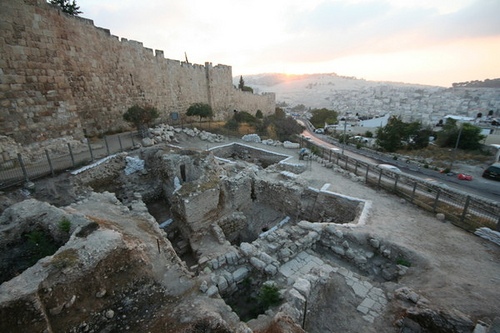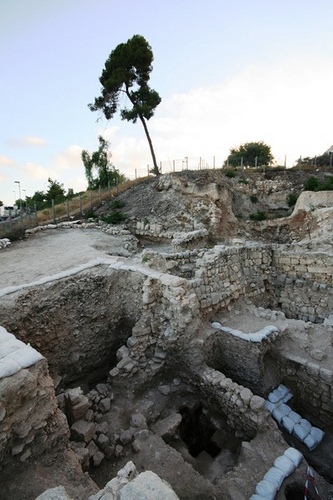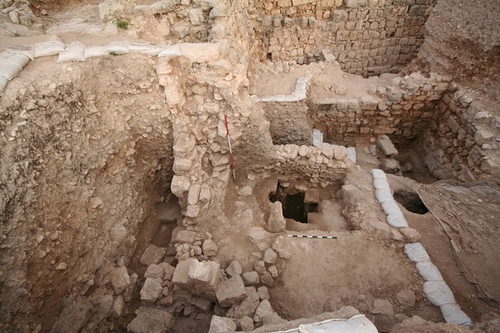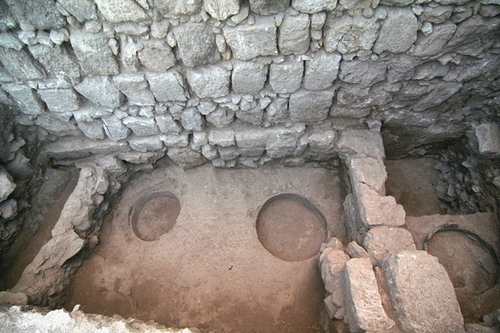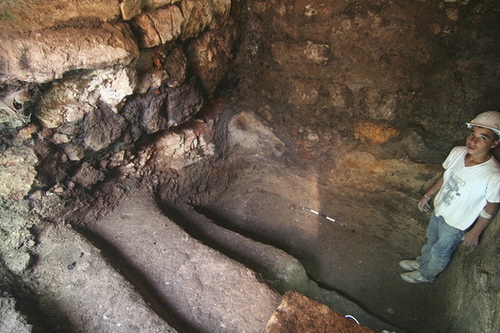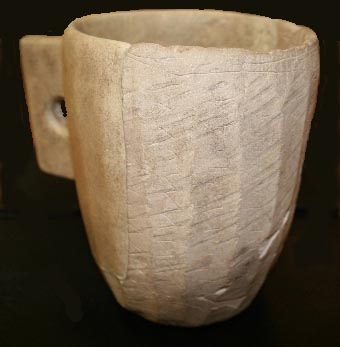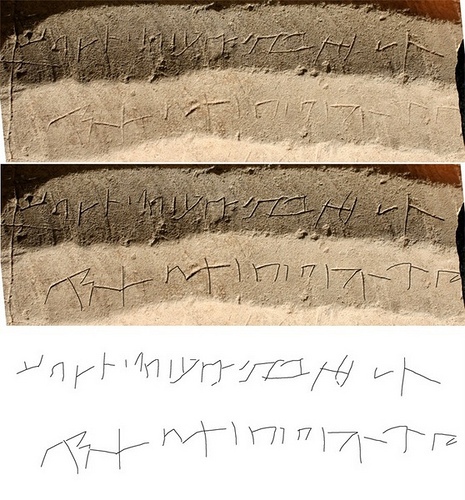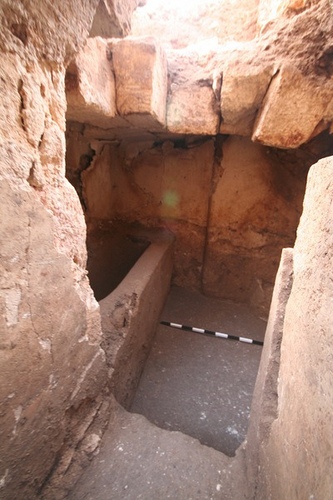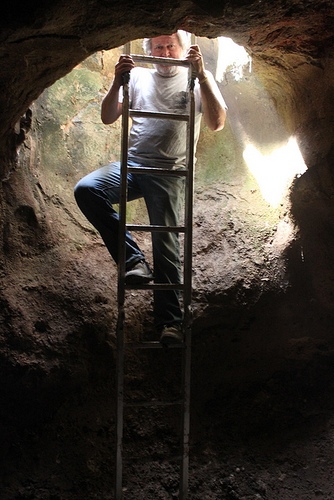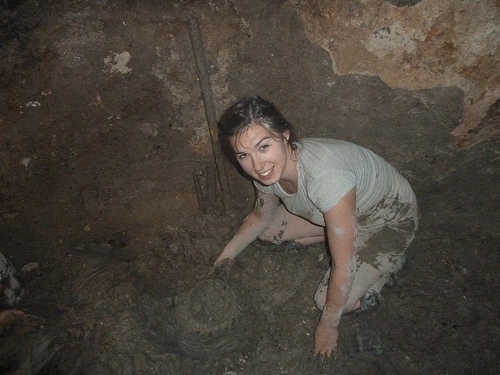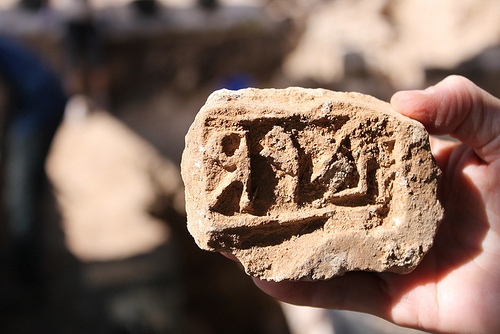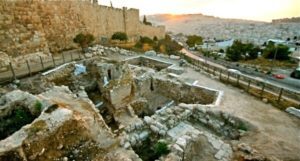
At first blush, anyone peering at the site from a distance might think it is a construction site. There are workers scattered about well-defined, squared-off open earthen pits and partial walls of stone blocks. Many of them are crouched down, close to the soil, appearing more like gardeners than construction workers. But some of them are wearing hard hats. There are sandbags placed in line at select locations, appearing to define work areas and spaces both shallow and steep. The area is fenced off, and it overlooks a busy road, traffic passing by with drivers mostly oblivious to what is happening in this place.
But if one looks closer, a very different picture emerges.
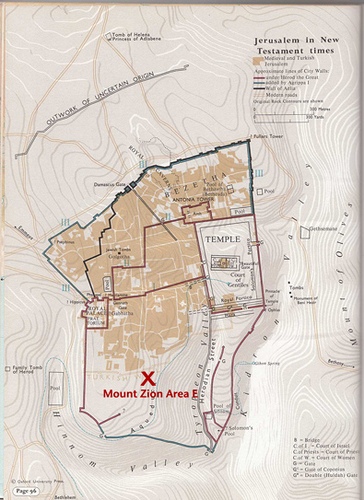 This is an archaeological excavation, and most of the “construction workers” are actually students and volunteers, along with a few professionally trained archaeologists and other specialists. Since 2007, these workers have been carefully and methodically peeling away layers of earth and stone and other debris in an effort to detect and reveal ancient walls, floors, and artifacts that have remained buried for hundreds if not thousands of years. Directing the operation is Shimon Gibson, a British-born Israeli archaeologist and adjunct professor at the University of North Carolina at Charlotte. He is also a Senior Associate Fellow at the W. F. Albright Institute of Archaeological Research. He, along with co-director James Tabor, a well-known scholar of early Christianity and Professor and Chair of the Department of Religious Studies at the University of North Carolina at Charlotte, is excavating an area adjacent to and below the southern Old City wall of Jerusalem. Referred to as the Mount Zion excavation because of its location in the sacred elevated area at the center of ancient Jerusalem near the historical Temple Mount (see map above), the work here is important because it is unearthing evidence of people who played out history in this place for thousands of years. It is set near a number of significant places in the history of this ancient city, such as the Praetorium where Jesus was tried before Pontius Pilate; the presumed location of the Last Supper of Jesus; the House of Caiaphas and those of other priestly families who lived during the time of Jesus; the large Nea Ekklesia of the Theotokos Church that Emperor Justinian commissioned in the 6th century and that was situated just above the site; and fortifications of the Crusaders and the Ayyubids.
This is an archaeological excavation, and most of the “construction workers” are actually students and volunteers, along with a few professionally trained archaeologists and other specialists. Since 2007, these workers have been carefully and methodically peeling away layers of earth and stone and other debris in an effort to detect and reveal ancient walls, floors, and artifacts that have remained buried for hundreds if not thousands of years. Directing the operation is Shimon Gibson, a British-born Israeli archaeologist and adjunct professor at the University of North Carolina at Charlotte. He is also a Senior Associate Fellow at the W. F. Albright Institute of Archaeological Research. He, along with co-director James Tabor, a well-known scholar of early Christianity and Professor and Chair of the Department of Religious Studies at the University of North Carolina at Charlotte, is excavating an area adjacent to and below the southern Old City wall of Jerusalem. Referred to as the Mount Zion excavation because of its location in the sacred elevated area at the center of ancient Jerusalem near the historical Temple Mount (see map above), the work here is important because it is unearthing evidence of people who played out history in this place for thousands of years. It is set near a number of significant places in the history of this ancient city, such as the Praetorium where Jesus was tried before Pontius Pilate; the presumed location of the Last Supper of Jesus; the House of Caiaphas and those of other priestly families who lived during the time of Jesus; the large Nea Ekklesia of the Theotokos Church that Emperor Justinian commissioned in the 6th century and that was situated just above the site; and fortifications of the Crusaders and the Ayyubids.
History and location are not the only factors that distinguish the site. It is also remarkably well preserved, due at least in part to construction work during Byzantine times. That construction required the establishment of an artificial leveling fill of stones, soil and other debris atop the remains of older Early Roman period house structures as a foundation to support new buildings. Then, construction of the Nea Church in the 6th century required excavation of underground reservoirs and the earth and stone from those excavations were subsequently dumped over the earlier Byzantine constructions.
“The area got submerged, ” Gibson said. “That’s why we found an unusually well-preserved set of stratigraphic levels.”*
______________________________________________________________________________________________________
Above, the Mount Zion dig site, and below, the site looking north with modern, Islamic, Byzantine, and Early Roman period layers exposed. Courtesy Shimon Gibson
____________________________________________________________
Digging the Priestly Upper Crust?
This isn’t the first time archaeologists have investigated this location. In the 1970’s, Magen Broshi of the Israel Museum conducted excavations on Mount Zion in at least several areas, and then in 2000 and 2005, excavations were resumed to record data from the earlier excavations and to clarify the site chronology in terms of the historical occupation of the site from the Second Temple period through to the Ottoman level. It became clear from these efforts that the site still held enormous potential. Renewed excavations began here in large measure in 2007 under a license from the Israel Antiquities Authority and the Israel Parks Authority and the sponsoring auspices of the University of North Carolina at Charlotte.
Archaeologists have now uncovered evidence of an urban occupation going back before the destruction of the Jewish First Temple, when Judahite kings ruled the city. “The earliest finds uncovered in the recent excavations are from the Iron Age II (eighth- sixth centuries B.C.E.), but nothing was found in situ, and building remains from this period have yet to be uncovered,” writes Gibson in a 2010 report. “A layer of soil was uncovered at one location above bedrock containing large quantities of Iron Age II pottery; its significance will be investigated in future seasons of work at the site.”**
But as the excavation progressed, the finds that generated the biggest splash in the popular press related to the Early Roman period and the 1st century CE, and more particularly the Herodian period (the time of Herod the Great).
Wrote Gibson:
“The basement of a well preserved dwelling was uncovered dating from the Early Roman period, with associated finds dating from the first century C.E. It included a plastered cistern, a stepped and plastered ritual bathing pool (mikveh) with a well preserved barrel-vaulted ceiling, and a chamber containing three bread ovens (tabuns)…….Numerous finds from the Early Roman period were found, including pottery, lamps, stone vessels (including a qalal jar rim with egg-and-dart decoration), scale-weights, murex shells, and coins. A fragment of an ornate window screen made of stone was also found. In fills situated above the rubble collapse of 70 C.E. there were a few Tenth Legion stamped roof tiles, but there were no signs of any construction activities in the area from the Late Roman period. The Early Roman period dwelling appears to have remained in ruins until the Byzantine period.”**
Both Gibson and Tabor knew they were on to something very significant. This was a residence that included its own cistern, its own mikveh, a barrel-vaulted ceiling, a chamber with three bread ovens, and part of an ornate window screen — not the stuff of a commoner’s home. Given the location of the structure not far from the most sacred spot in 1st century Jerusalem — the Second Temple — and the presence of what appeared to be a possible personal household mikveh – could they be looking at a Herodian period residence of a wealthy or important person, perhaps in some way connected to the Temple?
Gibson and Tabor suggest that this may indeed be the case.
Tabor hypothesizes one step further: “Caiaphas’s house has been located. It’s up on the hill just a few hundred yards from our site……..Caiaphas is the son-in-law of Anas, [who] had seven sons who were high priests, starting from before Jesus all the way down to the destruction of the Temple in 70 CE. So he ran the show for about 50-60 years, putting his sons in one after another, and finally a son-in-law, Caiaphas. My guess would be that we’re in one of the homes of that extended priestly family……”****
The large collection of murex shells could also be telling. The murex is a genus of Mediterranean sea snail that was used to produce a purple dye, highly valued by members of the aristocracy in the Roman world for coloring their clothing. It represented a mark of distinction for royalty and members of the upper classes of society.
“This color was highly desired,” said Gibson. “The dye industry seems to be something that was supervised by the priestly class for the priestly vestments and for other aspects of clothing which were vital for those who wished to officiate in the capital precincts.”*
Gibson theorizes that the shells may have been used as a means to identify varying grades of dye, as this can differ from species to species of the snail. Perhaps the priests were involved in the industry in some way, and if so, this says something new about the lives of these people – something that is not apparent in the historical record and that could only have been discovered through the archaeological process.
“It is significant that these are household activities which may have been undertaken by the priests,” Gibson said. “If so, it tells us a lot more about the priests than we knew before. We know from the writings of Josephus Flavius and later rabbinical texts about their activities in the area of the Jewish temple, but there is hardly any information about their priestly activities outside the holy precinct. This is new information, and that is quite exciting. We might find in future seasons further aspects of industries which were supervised by these priestly families.”*
_________________________________________________________________________________________
Looking down into the area of the basement of the Herodian period house. Courtesy Shimon Gibson
__________________________________________________________________________________________
The bread ovens, found in the basement of the house. Courtesy Shimon Gibson
_________________________________________________________________________________________
The stepped ritual bathing pool, or mikveh, found in the basement of the house. Courtesy Shimon Gibson
__________________________________________________________________________________________
A finding in 2009 added more grist to their interpretation.
“Among the special finds from the 2009 season of excavations was a soft white limestone cup dating from the first century C.E. bearing an incised inscription, with ten or perhaps eleven lines of script on its sides,” wrote Gibson.**
The cup (pictured left) was found in four pieces within a fill layer containing 1st century pottery fragments above a barrel-vaulted ceiling of a mikveh. It represented a well-known type of 1st century cup found in excavations throughout Jerusalem and beyond. The inscription on the cup has not yet been completely and definitively translated, but study of the cup and the historical context of its finding suggests that it might have been a ritual cleansing cup, used for the washing of hands before engaging in liturgical functions. Suggests Gibson, “the discovery of the cup in the area of the Upper City of Jerusalem, in which priestly families are known to have resided (including the Qatros family), may hint at the original priestly function that this specific vessel had some two thousand years ago.”**
_______________________________________________________________________________________________________________________
_______________________________________________________________________________________________________________________
A detailed examination of the inscription was made by Stephen Pfann, the staff epigrapher, using special photographic enhancing methods (PTM/RTI imaging) in order to clarify the fine spidery writing and to exclude accidental marks and incisions.
Pfann’s study has shown that there are ten, or possibly even eleven, lines of script visible on the vessel, with the rest of the facets filled up with zig-zag lines, perhaps intentionally in order to ensure that no further script might be added to the vessel. Pfann has identified three different scripts in the inscription: (1) a script previously known from the Dead Sea Scrolls as “Cryptic A” script (Pfann also calls this “Hebrew Hieratic”); (2) an unknown cryptic script which is unique to this specific inscription, even though some letters bear a resemblance to cryptic letters and signs already known in the Dead Sea Scrolls; and (3) the standard Jewish/Aramaic square script of the period (with only a few words evident in lines 5-6). Another interesting feature is the appearance of repeated letters: he (appearing four times in line 4), yud (appearing four times in line 7), waw (appearing four times in line 7), and tsade (appearing four times in line 10). Were these letters written without purpose, or did each one of these letters signify a repeated musical notation or prayer?
Clearly the scribe who made this inscription did not want it to be easily read, and to that end this person deliberately did not provide word dividers and intentionally wrote a text with a variety of scripts. Interestingly, Pfann has suggested that lines 5-6 might even be a paraphrasing of Psalm 26:8, and the words “Adonai shavti…” are fairly clear, even if the rest is not.
—- Shimon Gibson, excerpts from Preliminary Report: New Excavations on Mount Zion in Jerusalem and an Inscribed Stone Cup/Mug from the Second Temple Period ** Image courtesy Shimon Gibson
__________________________________________________________________________________________
__________________________________________________________________________________________
Then, in 2013, they made yet another major discovery.
While continuing to excavate near the mikveh within the building basement, they uncovered a vaulted chamber that contained what appeared to be a well-defined plastered bathtub. It was among only three other such Second Temple period rooms found so far in Israel. Two of them were in palaces of Herod the Great. Gibson believes that the addition of the bathroom feature is a clear sign of wealth and status.
“The bathroom is very important because hitherto, except for Jerusalem, it is usually found within palace complexes, associated with the rulers of the country,” Gibson said.”We have examples of bathrooms of this kind mainly in palatial buildings.”*
A nearly identical bathroom was found through previous excavations in the Jewish Quarter of the city. It is, according to Gibson, “only a stone’s throw away”. “The building in the Jewish Quarter is similar in characteristics to our own with an inscription of a priestly family,” Gibson added. “The working theory is that we’re dealing [here] also with a priestly family.”*
_________________________________________________________________________________________
The house “bathroom”. Note the bathtub to the left. Courtesy Shimon Gibson
_________________________________________________________________________________________
Cisterns and Hiding Places
As previously mentioned, among the uncovered features of the residence is a large, 30-foot deep oval-shaped cistern. As 1st century CE cisterns in Old Jerusalem go, there was nothing initially unusual about it. But this one contained a few surprising finds — cooking pots, charcoal, evidence of burn marks, storage jars, and remains of an oven.
In 1st century Jerusalem, cisterns, often public access facilities, were in common use among the city’s inhabitants as a means to collect and store water, a highly valuable commodity in Judea’s dry climate. So what were these objects doing at the bottom of a cistern? Would the residents have simply discarded them there once they became unusable, like depositing trash into a garbage dump? As precious as clean water cisterns must have been to the inhabitants of Jerusalem in this environment, it would be an unlikely scenario.
But Gibson and Tabor suggest a possible explanation.
“We still need to look at this material very carefully and be absolutely certain of our conclusions, but it might be that these are the remnants of a kitchen in use by Jews hiding from the Romans,” said Gibson. “Their last resort was to go into these cisterns. It was a common practice, but this conclusion is theoretical. It makes for a very good story and it does look that way, but we’ve got to be certain.”*
Historically, subterranean features such as cisterns and tunnels were used by the Jews to escape the pursuit of the Romans during the First Jewish Revolt. Flavius Josephus, for example, in The Jewish War, writes the following:
One John, a leader of the rebels, along with his brother Simon, who were found starved to death in the cisterns and water systems that ran under the city. Over 2000 bodies found in the various underground chambers, most dead from starvation. (Josephus, War 6:429-433)
Moreover, not far from the Mount Zion site, archaeologists excavating in the ancient Ophel area near the Temple Mount (or Haram Ash-Sharif) of Jerusalem have uncovered a plaster-lined cave with an associated system of subterranean tunnels. Under the direction of Dr. Eilat Mazar of the Hebrew University, excavators removed uncounted bucket-loads of dirt and rock fill from the cave, discovering in the process that its walls had been lined with a layer of plaster. The cave also appeared to be connected to a structure dated to the First Temple period (10th to 6th centuries BCE) above it, which featured water channels for directing water into the cave. This suggested to the archaeologists that they were actually exploring what was originally an ancient water cistern. But this cave excavation revealed some surprises. Says Brent Nagtegaal, an excavation supervisor, “we started to find a layer that related to the time just following Herod the Great during the Herodian Period. We were quite surprised that we would find stratified layers inside this cistern, and as we went underneath them we started to find walls, walls that indicate that there was some type of occupation or at least construction that took place inside the cistern after the cistern had lost its use for water.”*** Excavators found that the Herodian Period walls related to yet another key feature of the cave or cistern — a system of tunnels carved from the rock, large enough to accommodate the passage of individuals from one location to another. Continues Nagtegaal: “You can see many signs of life in here. You can see chisel marks that exist on the walls which really indicate the direction at which the tunnels were constructed, and you can see holes where candles would have been placed and their burn marks. You also see little foot steps and handholds in vertical shafts.”*** The tunnels also revealed numerous shards of Herodian Period pottery, a ceramic type used to date the tunnels and shafts.
So was the cistern with the cooking pots and oven excavated by Gibson and Tabor’s team actually part of the same story?
The jury is still out on this interpretation, but as Gibson notes, “it makes for a very good story”.
_________________________________________________________________________________________
Co-director James Tabor descends into the cistern. Photo credit Lori Woodall
___________________________________________________________
Cleaning out the cistern, student excavator kneels by a 2,000-year-old cooking pot. Photo credit Lori Woodall
___________________________________________________________
A tile fragment recovered during the excavations. The tile fragment shows the stamp of the 10th Roman Legion. This legion fought and occupied Jerusalem and Judea during the time of the First Jewish Revolt, the time when many Jerusalem residents took up hiding in subterranean tunnels and cisterns. Photo credit Lori Woodall
____________________________________________________________
Moving Forward
The Mount Zion excavations are really about much more than the 1st century world of Judaism and Christianity. In addition to the Iron Age II and Early Roman period layers, archaeologists have uncovered the remains of a strong Byzantine presence and strata representing Islamic cultures from the Umayyad through the Ottoman periods (the 7th to 12th centuries CE). Finds have included a threshold to a gate dating back to Saladin. “Here, in this site,” said Gibson, referring to the Islamic layers, “we have three superimposed levels — belonging to the Umayyads (seventh to mid eighth centuries), Abbasids (mid-eighth to ninth centuries) and Fatimids (ninth to eleventh centuries)– which allow us to reconstruct the cultural life in the houses from these periods.”*
The excavations are expected to continue for at least two or three more seasons. Much can happen in that time. Only a fraction of the site has been excavated thus far, and as so often happens in archaeology, theories and hypotheses can be challenged or overturned. In terms of the 1st century finds, Tabor makes clear that what the team is uncovering is not about a single find or discovery. “It’s not necessarily one house,” he says. “We’re uncovering a significant area of 1st century Jerusalem. The big news [of the latest, 2013 season] is the bath. But it’s what the bath really means. What it means is that we have significant areas of well-preserved material where we are. The bath is just the beginning……..”****
____________________________
Individuals interested in learning more about the Mount Zion excavations and/or who wish to participate financially may go to the UNC website. Additional direction for individuals interested in participating as dig volunteers may go to the Dig Mount Zion website for more information. This website also includes more in-depth information about the excavations, finds, and history.
The UNC Charlotte dig, licensed by the Israel Antiquities Authority and the Israel Parks Authority, is the only archaeological excavation in Jerusalem currently being conducted under the leading sponsorship of an American university. While the 2013 excavations have been completed, work is expected to continue on the site during the summers of 2014 and 2015. The work was made possible through the generous support of The Friends of Mount Zion, a group of private funders organized by the Office of Development at UNC Charlotte. Other assistance was provided by the University of the Holy Land and The Foundation for Biblical Archaeology.
____________________________
* University of North Carolina press release, James Hathaway, University of North Carolina at Charlotte, 17 September 2013
** Gibson, Shimon, Preliminary Report: New Excavations on Mount Zion in Jerusalem and an Inscribed Stone Cup/Mug from the Second Temple Period, University of North Carolina at Charlotte and University of the Holy Land, Jerusalem, 2010.
*** Archaeologists Excavate Jerusalem Cave and Tunnel Network, Popular Archaeology Magazine, Vol. 11, June 2013.
**** UNC Charlotte Mount Zion Excavation, Charlotte Talks, WFAE 90.7, 1 August 2013.
Map image of Mount Zion excavations location courtesy Shimon Gibson and Mount Zion Excavations Project.
_________________________________________________________________________________________
Did you like this? Read more articles like this with a premium subscription to Popular Archaeology Magazine.

